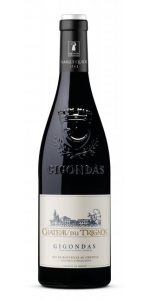Wine from Quiot Family
Since 2006, the Quiot Family, charmed by the Dentelles de Montmirail and its products of character, owns the Château du Trignon in order to perpetuate it, while expanding it by 10 ha of Vacqueyras and a few hectares of Beaume-de-Venise.
"Respectful of achievement but rich of our wine-maker knowledge, we have adopted this land whose singularity fits in with all our other properties, in the same line of tradition, quality and adaptation."
The origin of the name Gigondas: two hypotheses.
The first one: he would pull it out of gignite undas, "emerged from the waters", like this mountain terroir concealing a gigantic underground reservoir.
The second one: of Latin origin, jucunda, which means “happy” and would be inspired either by Jucundus, the first owner of the place, or by its pleasant position and the pleasures of the surrounding hunting ... or even the pleasure of wine itself.
The cultivation of the vine goes back to antiquity. If the veterans of the Second Roman Legion are credited with creating the first wineries, the discovery of vats for storing wine is another clue. We then note that the oldest written mention of a Gigondas vineyard is from the 12th century. Gigondas is the first Côtes du Rhône Villages to reach the rank of Cru on January 6th 1971.
In the appellation, the terroirs are made up of large alluvial terraces of stony red clay, of Mindelian origin, which extend to the foot of the Dentelles de Montmirail. Their high permeability allows rapid drying of the plots. These soils, rich in clay, are characteristic of the terroirs of great vintages.
On the estate, we have 3 terroirs: -clay and limestone molasse; alluvium with exploded pebbles; safres and sandstone.
Partial de-stemming. Vatting time: 3 to 4 weeks. MLF and maturing in oak for a proportion.
Gigondas offers a rich bouquet, with fine, fruity and spicy aromas and a sunny color ranging from ruby to dark garnet. The nose reveals a bouquet of red fruits and very ripe black fruits. On the palate, the Gigondas is full-bodied with a fleshy attack. The Grenache Noir releases all the expression of its power in this shimmering red wine with marked tannins, a structured body and a great aptitude for aging. Syrah and Mourvèdre reinforce their garnet color and spice up their aromas.
Review:
- Wine Enthusiast , Anna Lee C. Iijima 94 Points
- back
Selected Options
Wineries
Categories
Pricing
Countries
Regions
Grape Types
Wineries
Organic/Free Shipping
I feel this wine expresses the greatness of California and its hidden pockets where Cabernet can excel. The cold Pacific Ocean running the entire length of the state presents maritime influences – and with each small distance eastward the climate warms. Stony soils, south facing slopes and moderately warm conditions are the keys to producing dark, rich and good tasting Cabernet.
A small release from Caymus Vineyards, this wine is a California-appellation Cabernet Sauvignon – supple, dark and rich, bearing the signature hallmarks of Caymus. It is sourced from sites throughout the state which feature climatic conditions, soils and topography that are ideally suited to Cabernet. This project stems from excitement over California's diverse vineyard land, often in lesser-known areas, with the potential to produce exceptional Cabernet.
Review:
Lastly, and a wine that will be a candidate for perfection in 4-5 years, the 2019 Châteauneuf Du Pape Centenaire reveals a deep ruby/purple hue as well as extraordinary notes of black cherries, licorice, iron, nori, and peppery garrigue. As with the base 2019, the estate did an incredible job with the tannins, and this wine is flawlessly balanced, with ultra-fine tannins, no hard edges, and the sheer class to evolve for 25+ years. This is a perfect example of power with no sensation of weight or heaviness. The blend in 2019 is 84% Grenache, 10% Mourvèdre, and 6% Syrah, and it wasn’t destemmed and was brought up mostly in concrete tanks, with just 6% in very old barrels.
-Jeb Dunnuck 98 Points





